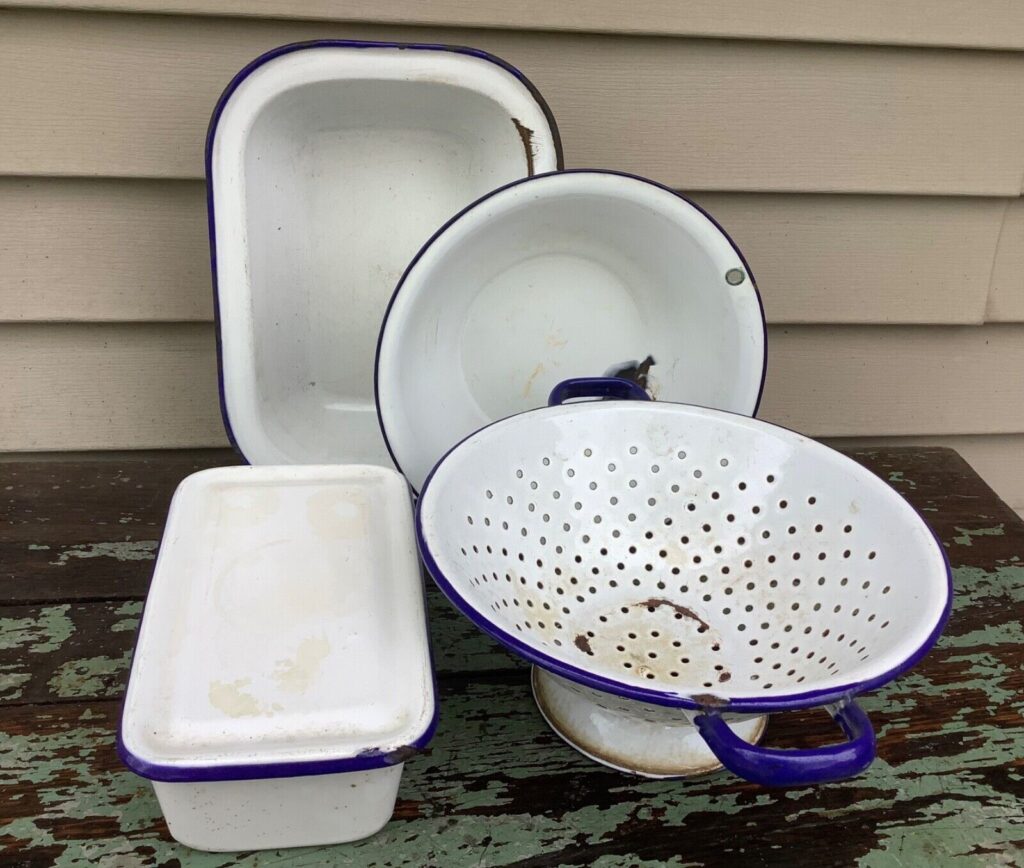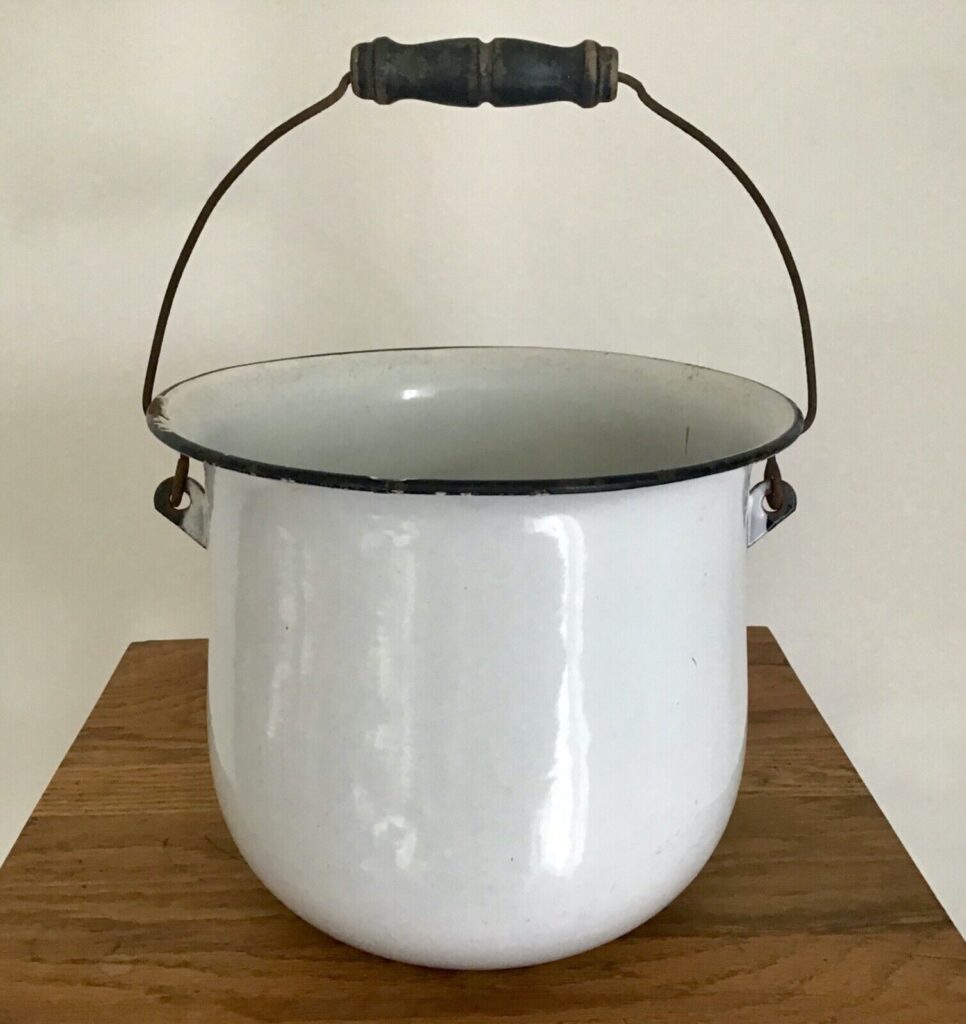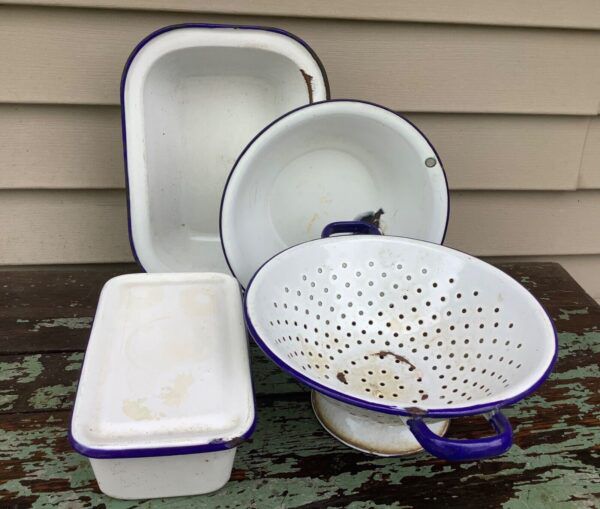#Ways #Repurpose #Vintage #Enamelware #WorthPoint

Recently, while out of town visiting family, I ventured into a local thrift store. After scouring the shelves filled with housewares, I spotted what I thought was a large enamelware mop bucket. It was rusty and chipped, but with a two-dollar price tag, I figured I would add it to my collection of vintage enamelware and likely find a purpose. Since I failed to grab a shopping cart, I proceeded to tote the bucket by its handle around the store while continuing to shop.
As I walked through the store, a shopper across the way yelled, “You found a thunder bucket!” Turning around, I realized she was pointing to the bucket dangling from my hand. Unfamiliar with the terminology, I asked her, “What’s a thunder bucket?” Approaching me, she explained the vessel I was parading around the store originally contained a matching lid and was used for collecting human waste. After turning three shades of red, I smiled—realizing I found a repurpose for my find—and quipped, “I guess I’ll use it for storing extra rolls of toilet paper.”
Like my thunder bucket, most early enamelware is used today for purposes other than its intended function. So, what was enamelware’s original purpose, and what are some clever ways to repurpose it?

ENAMELWARE’S ORIGINAL PURPOSE
Enamelware is metal kitchenware covered with an enamel surface, creating a porcelain-like finish. Introduced in Germany, enamel-lined cookware—like pots, kettles, baking pans, and utensils—became commonplace in American homes around 1850. The enamel-coated metal, aluminum, or cast-iron kitchenware prevented rust from getting into food, was easy to clean, and was acid-resistant.
Available in a wide range of colors and designs, enamelware appealed to the American masses. Later, manufacturers expanded their product line beyond the kitchen to include other items, like thunder buckets and washbasins. However, popularity declined in the 1930s when competition won out from aluminum, stainless steel, plastic, and the highly successful Pyrex kitchenware. During the 1960s, American manufacturers began producing enamelware again, which continues in production today. However, the original enamelware is more popular among collectors.
EARLY COLORS, PATTERNS, AND DESIGNS
Early enamelware can be found in solid colors with contrasting-colored rims and handles. The most common solid-color enamelware is white. However, it also came in cobalt blue, aqua, turquoise, purple, pink, yellow, gray, brown, and black. Later colors include red, bright green, harvest gold, dull orange, and avocado green. Scarcer colors are purple, pink, yellow, brown, and black.

Besides solid colors, vintage enamelware came in patterns like swirls, spatters, speckles, and mottling. A popular pattern whose name is often synonymous with enamelware is gray graniteware, which resembles the look of granite. Originally called Granite Ironware, graniteware was manufactured in 1874 by the St. Louis Stamping Company of Illinois. Another popular pattern among collectors is agateware, typically blue in color with a marbled pattern similar to agate minerals.
During the 1920s and 30s, enamelware sported decorative designs like fruits, polka dots, hearts, leaves, flowers, and more. Inspired by European influence, some pieces included lettering of the intended contents like flour, sugar, tea, and salt.

HOW TO REPURPOSE ENAMELWARE
Since enamelware’s enamel lining can easily crack and chip off due to mishandling or temperature change, most early pieces are unsafe for cooking, baking, food storage, or food serving. Typically, those chipped-off surfaces expose the metal underneath, which can rust over time, which is why most vintage enamelware is found chipped and rusty. Even if you find early enamelware in perfect condition, it is not recommended for food use since early coloring agents, like cadmium and uranium, were frequently used and can leach contaminants into food.
However, early enamelware can serve several uses. Often, its chipped and rusty surface adds vintage character to a space. Consider these ten clever ways to use your enamelware collection for repurposing:
- Use pans with small holes in the bottom as a planter for house plants. Place an enamelware plate or saucer underneath to catch excess water that drains from the pan.
- Hang a sheet pan (jelly roll tray) on a wall and use it as a magnetic memo board. You could also use it as a serving tray or entryway catchall for keys and sunglasses.
- Fill a large washbasin with ice and stock it with bottles of water, soda, and beer for a backyard party. Be sure the basin has no holes or cracks in the bottom for melted ice to leak out. If your washbasin has holes in the bottom, use it to plant an outdoor container garden.
- Place a large baking pan atop the kitchen counter to corral a stack of cookbooks.
- Use a collection of pot lids as unique burner covers on your stovetop. You could also attach a single lid on the side of your kitchen cabinet and hang a towel from the handle.
- Use pitchers and kettles to hold a dried or faux flower arrangement. If you use real flowers, first test the enamelware for water leaks.
- Place a refrigerator box on the bathroom counter to keep necessities like a jar of cotton swabs, lotion, or rolled-up washcloths at the ready.
- Use a lunch pail or berry bucket in your laundry room to store dryer sheets, dryer balls, and laundry detergent pods.
- If you are feeling crafty, make a tiered stand using a larger bowl for the base and a smaller bowl for the top. Attach the bowls with a wooden spindle screwed into the bottom of each bowl. Fill the bowls with seasonal décor you can switch out each season.
- Another crafty idea is to make a hanging bird feeder using a pie plate. Fasten three metal chains to the rim of the pie plate and then attach the chain’s other ends to an “S” hook. Secure the “S” hook to a sturdy tree branch. Add a few rocks inside the pie plate to steady it in the wind, and then add birdseed on top of the rocks.
REVIVING VINTAGE ENAMELWARE
Early enamelware is fun to collect and repurpose. Most vintage enamelware, especially if damaged, is usually affordable, so you won’t feel guilty about altering it for a new purpose. Besides, it will revive the piece and provide distinctive décor for your home.
Karen Weiss is a freelance writer and enjoys decorating her home with vintage finds from her many collections. She also has an Etsy shop called SimplePatinaFinds.
WorthPoint—Discover. Value. Preserve.




